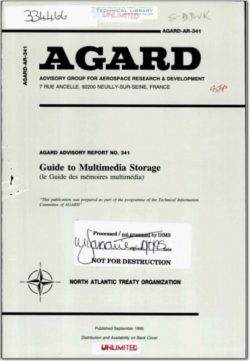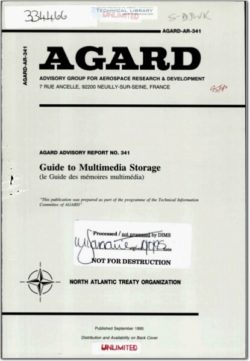AGARD-AR-341

- Version
- 145 Downloads
- 6.52 MB File Size
- 1 File Count
- March 8, 2016 Create Date
- March 8, 2016 Last Updated
Guide to Multimedia Storage

The guide to multimedia is a review of the current storage devices
available for accessing, retrieving, and storing information. The dis-
cussion addresses the principal devices available. A selected bibliog-
raphy is provided as a reference tool for further inquiry.
The type of multimedia devices used in an information storage and
retrieval environment will vary with the size of the collection, the
demand for information, and the retrieval capability required. While
there are several methods of storage available, ease of access, cost,
reading and writing capabilities, and durability are a few of the issues
that should be addressed in determining the needs of an information
center.
This guide provides information on twelve major storage devices. A
description is provided on their benefits, limitations, durability, plat-
form capabilities, comparison, storage capacity, physical characteris—
tics, data capacity, ease of use, copying capability, cataloguing rules
and data standards.
There are three major groupings to this guide. The first is optical
storage capability. CD-ROM, optical disk, and photo CDare-reviewed.
The second is magnetic storage. This grouping includes magnetic tape,
video tape, tape cassette and cartridge, floppy disk, hard disk, and
removable storage systems. The third grouping is defined as other
media storage. ‘Photo media, audio material and motion picture com-
prise this group.
Regardless of the storage device used, the key is effective manage-
ment to enable immediate access to information when required.
A CD-ROM disc can hold vast amounts of data, not just text, but also
pictures, sound, and animation. CD-ROM can store 600-700 MB of
data. When a CD-ROM contains any combination of video, sound, text,
graphics and/or automation, the product is considered a multimedia.
It can also be mass produced very cheaply. CD-ROM is compact,
lightweight, and durable. Best of all, information contained on a CD-
ROM disc is indexed and cross—referenced so that you can quickly find
and display any piece of data on the disc. It is also becoming the dis—
semination medium of choice due to its long storage life relative to
other media.
| File | Action |
|---|---|
| AGARD-AR-341 Guide to Multimedia Storage.pdf | Download |

Comment On This Post